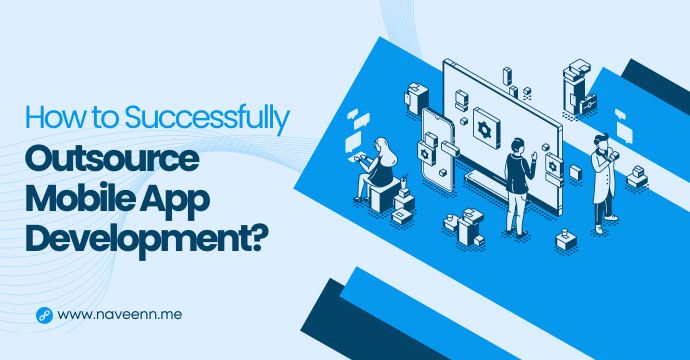Outsourcing mobile app development can be a game-changer for businesses looking to leverage expertise and efficiency without the overhead costs of an in-house team. However, the process can be fraught with challenges if not managed correctly. This guide provides a comprehensive roadmap to successfully outsource mobile app development.
Why Outsource Mobile App Development?
- Cost-Effectiveness: Outsourcing can significantly reduce costs. Hiring and maintaining an in-house team can be expensive due to salaries, benefits, and overhead costs. Outsourcing allows you to pay for the expertise you need only when you need it.
- Access to Expertise: Outsourcing gives you access to a global talent pool. You can tap into specialized skills and expertise that may not be available locally. This ensures your project benefits from the latest technologies and industry best practices.
- Focus on Core Business: By outsourcing development tasks, you can focus on your core business activities. This can lead to better productivity and growth as you allocate more resources to your primary business functions.
Read More: Empower Future with an Innovative Mobile App Development
Steps to Successfully Outsource Mobile App Development
Step 1: Define Your Project Requirements
Before approaching potential outsourcing partners, clearly define your project requirements. Outline the app’s purpose, target audience, key features, and desired outcomes. Detailed requirements help ensure that both you and the development team have a clear understanding of the project scope.
Step 2: Research and Choose the Right Partner
Finding the right development partner is crucial. Here’s how to do it:
- Portfolio Review: Examine the portfolios of potential partners. Seek developers with experience creating apps similar to yours.
- Client References: Ask for client references and contact them to get feedback on their experience.
- Technical Expertise: Ensure the team has the necessary technical skills and experience with relevant technologies.
- Communication Skills: Effective communication is vital. Assess their communication skills and responsiveness during the initial interactions.
Step 3: Define Clear Milestones and Deliverables
Establish clear milestones and deliverables to keep the project on track. Break down the project into manageable phases, each with specific goals and deadlines. This approach allows for regular progress reviews and timely identification of potential issues.
Step 4: Set a Realistic Budget
Determine a realistic budget for your project. While cost-saving is a significant advantage of outsourcing, it’s essential to avoid the lowest bid if it compromises quality. Discuss the budget in detail with your outsourcing partner and ensure all costs are transparent.
Step 5: Create a Detailed Contract
A detailed contract protects both parties and sets the groundwork for a successful partnership. The contract should include:
- Project Scope: Clear description of the project and deliverables.
- Timelines: Specific deadlines for each milestone.
- Payment Terms: Agreed-upon payment schedule.
- Confidentiality: Non-disclosure agreements to protect sensitive information.
- Ownership: Clear terms regarding the ownership of the code and intellectual property.
- Termination Clauses: Conditions under which the contract can be terminated by either party.
Step 6: Maintain Regular Communication
Regular communication is crucial to the success of an outsourced project. Schedule frequent check-ins and updates to discuss progress, address concerns, and make necessary adjustments. Tools like Slack, Zoom, or Microsoft Teams can facilitate seamless communication.
Step 7: Use Project Management Tools
Leverage project management tools to keep everything organized. Tools like Trello, Asana, or Jira can help you track progress, manage tasks, and collaborate efficiently. Ensure that both your in-house team and the outsourcing partner are comfortable using these tools.
Step 8: Conduct Regular Reviews and Testing
Regular reviews and testing are essential to ensure the app meets your expectations. Conduct periodic code reviews and usability testing at each milestone. This iterative approach allows you to catch and fix issues early, ensuring a higher-quality final product.
Step 9: Plan for Post-Launch Support
Your app will need support and maintenance post-launch. Discuss and agree on post-launch support terms with your outsourcing partner. This should include bug fixes, updates, and potential feature enhancements.
Step 10: Build a Long-Term Relationship
Building a long-term relationship with your outsourcing partner can be beneficial for future projects. A reliable partner who understands your business and requirements can deliver better results over time. Foster a positive working relationship through clear communication, timely payments, and mutual respect.
Conclusion
Successfully outsourcing mobile app development requires careful planning, clear communication, and ongoing collaboration. By following these steps, you can mitigate risks and ensure a smooth development process that results in a high-quality mobile app. Whether you’re a startup or an established business, the right outsourcing strategy can accelerate your project and help you achieve your business goals. Embrace the potential of outsourcing and turn your mobile app vision into reality with confidence.

Pingback: The Importance of API Integration in App Development
Pingback: Why Does Your Business Need a Mobile App in 2024?